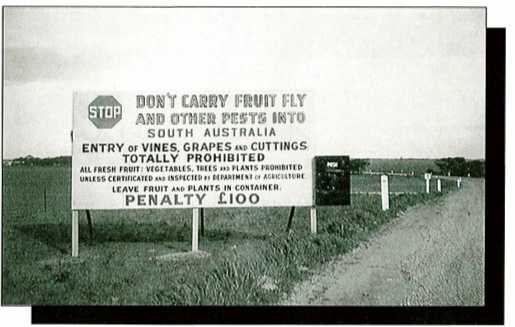Prevention
Before roadblocks were established, only commercial consignments of fruit were inspected, usually at Mile End, Adelaide. However, movement of fruit into South Australia by travellers in vehicles was identified as a likely means of introducing fruit fly. Between 1953 and the summer of 1960–61, police motorcycle road patrols operated on the South Australian border near Renmark, Bordertown and Mt. Gambler. They had the power to enforce the provisions of the Vine Fruit and Vegetable Act. Police enforced quarantine regulations in 1963 by routine observation of interstate traffic for breaches of quarantine regulations and regular clearing of fruit and plants left in the bins provided with quarantine signs.
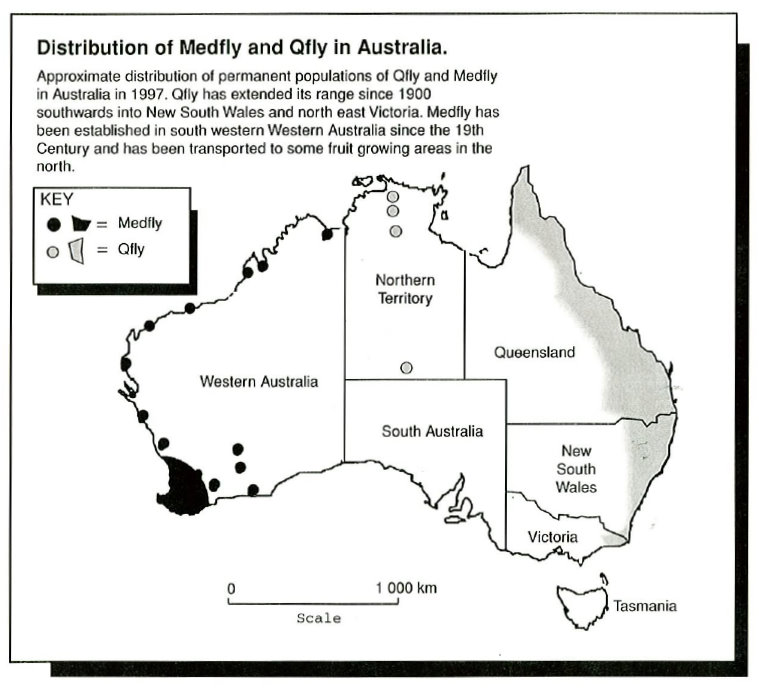
Roadblocks
The South Australian Government has financed the establishment and operation of roadblocks as a means of reducing the risk of introduction of fruit fly. The Commonwealth Government was asked during 1961 to cooperate with States government in a plan to establish a line of roadblocks across the south-eastern part of Australia. The Federal Government did not participate, and the states have variously operated roadblocks according to their own needs with little co-ordination. Roadblocks operated by the Victorian Department of Agriculture along the Victoria – New South Wales border, provided a first line of defence against fruit fly entering South Australia through Victoria, until May 1983, when they were removed by the Government of Victoria.
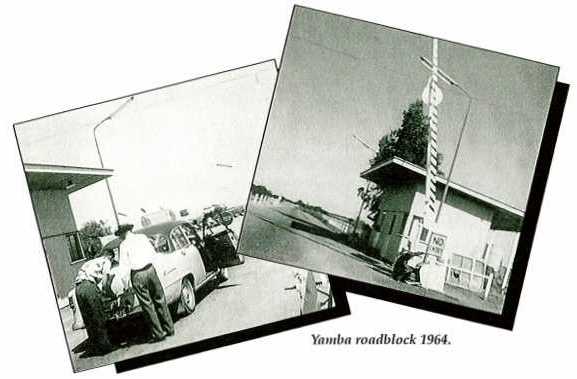
An inspector under the South Australian Fruit and Plant Protection Act, 1992 may stop, detain and inspect any vehicle in or on which there is reasonable suspicion that any fruit or plant may be affected by a pest or disease. Under the Act, travellers are encouraged to surrender fruit for destruction. Since November, 1977 data collected by roadblock inspectors include the number of vehicles carrying fruit, the weight of the fruit taken, any evidence of larvae and the State and registration number of the vehicle from which the fruit was taken.
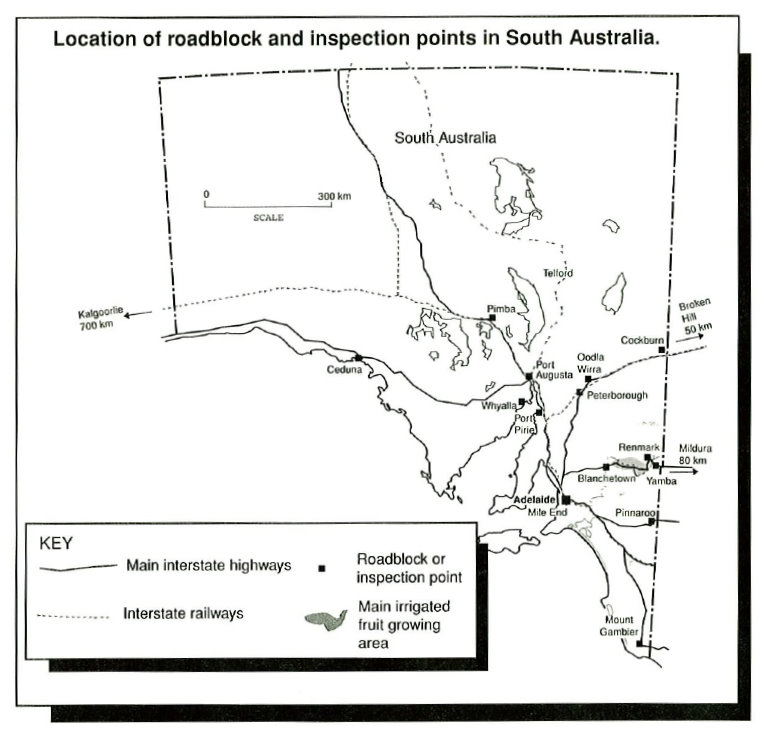
Eastern roadblocks
Fruit fly larvae bred from fruit collected from eastern roadblocks are Bactrocera species, mainly Qfly, consistent with their movement from fruit fly areas in eastern states.
The first South Australian roadblock was established at Yamba in 1957, primarily as a response to the discovery of an outbreak of Qfly at Mildura. In 1965 a boom gate was erected across the Stun Highway at Yamba to better control traffic. In 1997 the Yamba roadblock operates full time throughout the year, to monitor traffic from the Murray Valley.
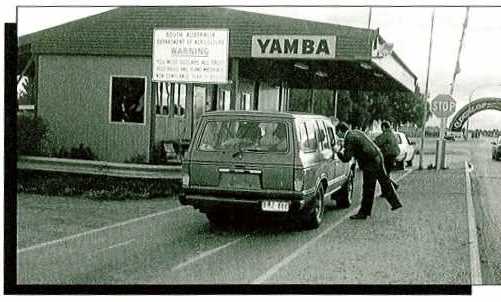

In 1962, a part-time roadblock was set up on the Wentworth-Renmark road (12 km east of Renmark) to inspect traffic which had previously by-passed the roadblock at Yamba. This roadblock was manned three days a week on random days and was finally closed in September, 1977 because of the low volume of traffic which used the road.
In 1959, part-time roadblocks were established at Blanchetown and Mt. Gambier for a trial period, but these ceased in 1961 as the volume of traffic and the limited amount of infested fruit intercepted could not justify the expense.
In 1960, a part-time roadblock was established at Cockburn because of outbreaks of Qfly at Broken Hill; it became permanent in 1961. Cockburn operated twenty-four hours a day year-round until May, 1980, when it was closed and relocated to Oodla Wirra in December 1980, to operate from December to May inclusive from 6am–10pm. The new site at Oodla Wirra was equipped with two boom gates to stop interstate traffic and allow local traffic through without inspection. Oodla Wirra presently operates 16 hours per day, 6am–10pm September–May and 7.6 hours per day, 8am–5pm June to August.
In 1963, in response to pressure from growers at Loxton who feared the introduction of Qfly from the east, inspectors from Yamba began to conduct a staggered four-hour daily survey at Pinnaroo. By June 1968, a part-time road block had been established there operating during daylight hours using a tent at first for a shelter for the on-duty inspectors. A casual employee erected a galvanised tin shed at his own expense. The South Australian Government approved the establishment of a Fruit Fly Inspection Station at Pinnaroo in January, 1971. Staff at this roadblock were halved in 1980 and it now operated sixteen hours a day (6am–10pm) between the months October to May inclusive and 7.6 hours per day 8am–4pm June to September.
An analysis in November 1977, of records from the four main border stations, Ceduna, Cockburn, Yamba and Pinnaroo for nine year period 1968–1977 showed that the critical period for inspecting traffic for Qfly was December to April inclusive, whi1e for the remainder of the year the risk of fruit fly introductions were comparatively low. However, for Medfly there was no obvious low risk period, and year-round inspection of traffic was justified. The frequency of fruit intercepted at night was much lower than during the day. As a result, the Cockburn station was operated for the period December to May inclusive and then only between 6am to 10pm.
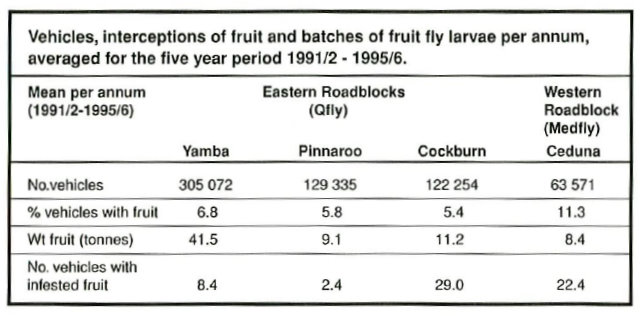
At Bordertown and Mt. Gambier there are quarantine “honesty” bins for the disposal of fruit by travellers.
Western roadblock
Samples of fruit fly larvae reared from the western roadblock have all been Medfly, consistent with an origin in Western Australia.
In 1957 a temporary roadblock was set up on the bridge at Port Augusta on Highway 1 following an outbreak of Medfly there. This roadblock was transferred in 1958 to Ceduna, where it was easier to intercept east-bound traffic, and in 1971 the roadblock was re-sited 1km from the original to prevent vehicles by-passing inspections. In 1965, inspection site at the Ceduna roadblock was tightened by closing a stock route which was being used as a by-pass. Two boom gates were erected at Ceduna in February 1987 to prevent vehicles speeding through the roadblock, which operates full time.
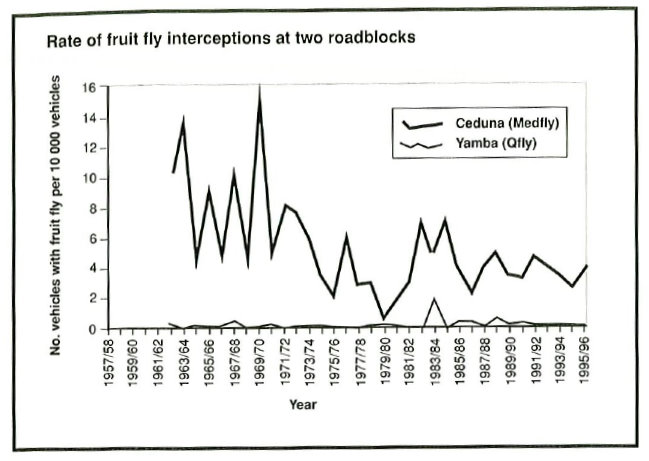
Administration of roadblocks
Administration of the roadblocks was first managed by staff of the Department of Agriculture headquarters in Adelaide and in August, 1983, technical supervision was transferred to the Officer-in-Charge, Pest Eradication Unit, Adelaide. When the Department of Agriculture changed to a regional structure, roadblock staff were jointly administered by Plant Industry Division, and the Chief Regional Officer of the Region. This dual management was simplified when the Department was reorganised in 1992 and roadblocks became a direct responsibility of the Horticultural Division, with local administration carried out by Service Delivery Managers.
Inspections of other transport
Rail inspections
From 1949 an endeavour was made to educate travellers about the dangers of introducing fruit fly. Notices, posters and announcements over public address systems were used at railway stations and police at Port Augusta and Port Pirie inspected trains as part of their duties. By 1974, Port Augusta had seven full-time and one part-time inspectors, Port Pirie had one full-time and one part-time inspector; and Peterborough had one part-time inspector. Route changes of trains from Perth in 1986 eliminated inspections at Peterborough, and finally Port Pirie. By 1992 all passenger train inspections ceased because little infested fruit was detected; during a three year period, for example, only one batch of infested fruit was detected.
Interstate passenger trains were inspected for fruit during a number of periods. The Melbourne–Adelaide train was inspected after 1954, when an Inspector boarded at Mt. Lofty each morning and inspected all passenger compartments. Inspections of the east-bound train from Perth started 1959 by an inspector at Pimba. Passenger trains from Perth to Adelaide were inspected between Port Augusta and Port Pirie until 1992. In that year, the timetable was changed so that trains from Perth arrived at Port Augusta at midnight; all inspections were cancelled to avoid disturbance to sleeping passengers. Inspections on west-bound trains from New South Wales started in 1961 when the Broken Hill–Adelaide express stopped at Cockburn where inspectors boarded the train. In 1970 the India–Pacific line came into operation and an inspector met passengers who disembarked at Peterborough for Adelaide. The south bound passenger train (The Ghan) from Alice Springs was inspected between 1959 and 1992 by an inspector who boarded at Telford.
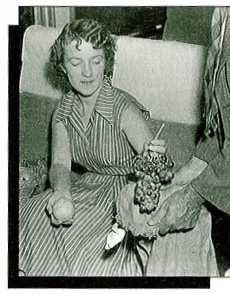
Airport inspections
Airline operators announced quarantine restrictions of fruit to passengers on aircraft entering South Australia but there was no check of luggage. By 1954, inspectors met all interstate aircraft at Adelaide and by their presence reminded passengers of their quarantine obligations, in addition to leaflets distributed by the airline companies. By 1965 every air-entry point either had honesty bins or inspection. Staff from the Ceduna roadblock inspected light aircraft at the Ceduna airport. The International terminal in Adelaide opened in 1982 and quarantine officers meet all aircraft from overseas.
Port inspections
In 1949, inspections began at the Port Adelaide Inspection and Fumigation Depot; and the few commercial imports of fruit were all inspected. In later years, inspection of commercial horticultural imports is obviated by an International health Certificate under the Commonwealth Quarantine Act. Garbage waste from all ships is incinerated at a Marine and Harbours facility.
Passengers on ships were also required to give up fruit in their possession. On the occasion when a passenger ship arrives at Outer Harbour, customs screen passengers for fruit and supply a disposal bin. In the past, mail ships made regular visits here; inspections of passengers revealed very little fruit.
Publicity
Fruit-fly publicity within South Australia is aimed at raising the awareness of South Australian residents of the impact of fruit flies on their lifestyle and to encourage them to report occurrences of larvae in fruit. It is also aimed at warning visitors and returning residents not to bring fruit into South Australia. The effectiveness of the publicity campaign may be measured by changes in fruit being brought into South Australia. The proportion of vehicles bringing fruit from Victoria has remained fairly constant at less than 10% during 35 years, while the proportion of cars carrying fruit from Western Australia has declined from nearly 30% in 1962–3 to about 12% in 1996–7.
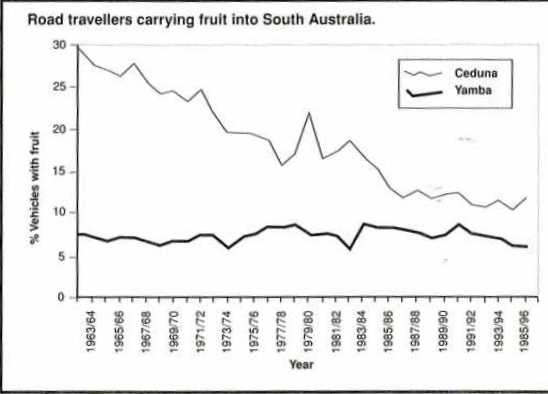
Lectures and talks
During the years 1970 to 1982, a special Education Officer, Sheila Morphett was appointed to visit schools and councils in the State and to give talks to interested groups. Talks were given to all class levels in primary and secondary schools, when a simple story of the biology of fruit fly and the ecological significance of the eradication program in South Australia were presented. Students received transfers and project material which included information for their parents. Most school teachers were pleased to receive this information, and many encouraged the children to undertake fruit-fly projects in association with social studies.
Television commercials
For many years, television advertising was found to be expensive and outside the financial ability of the Pest Eradication Unit. In 1983, Channel 9 made two 10 second commercials at a reasonable cost, and these were shown in the 1983–84 and 1984–85 seasons.
Signboards
In 1947, Department of Agriculture co-operated with the Phylloxera Board to erect eight notices on the Victoria-South Australia border roads aimed at warning road travellers against transporting fruit and vines into South Australia. These signs were erected at Frances, Pinnaron, Penola, Coorong motor by-pass, Mt. Gambier aerodrome, Renmark-Mildura road and Parafield aerodrome. Later, four new signs were erected at Outer Harbour and Pt. Adelaide, followed by Adelaide and Murray Bridge railway stations.
In 1963, a contract was let for the construction and maintenance of 25 roadside border signs. One was on the west coast, two in the far north, nine in the Murray Mallee and thirteen in the South East. By 1965, all road, rail, air and sea entry points into the State were covered by either a quarantine barrier or signboards. In 1973, these signs were replaced on major roads at Ceduna, Cockburn, Pt. Augusta, Renmark–Wentworth, Renmark–Lindsay Pt., Pinnaroo, Bordertown, Naracoorte–Apsley, Glenburnie and Mt. Gambler–Nelson, each with a large sign, a satellite sign and an honesty bin. Twelve minor roads had one large sign each; they were at Noora, Taplan, Murtho, Ellerslie, Wrattonbully, Penola–Casterton, Mt. Gambier–Casterton, Mil Lel–Casterton, Mt. Gambier–Heywood, Wanuarra, Francis and Binnum. Other signs in the State were at the Adelaide airport (two), Parafield airport (two plus bin), Yamba roadblock, Outer Harbour, and Nos. 2 and 18 Berths at Pt. Adelaide.
Eighteen signs on major road-entry points are currently maintained by a contractor and the remainder by the Department.
